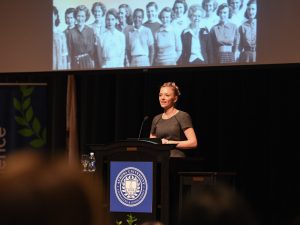Author tells the forgotten stories of NASA pioneers helped shaped space exploration
By Cathy Janek for Chronicle Media — February 14, 2018
Author Nathalia Holt spoke last week at Aurora University about the women who helped shape space exploration. (Aurora University photo)
Mulling over names for their new baby on a road trip from California to Boston, the husband of researcher and science writer Dr. Nathalia Holt suggested the name Eleanor Frances.
Nathalia Holt was immediately intrigued.
A Google search uncovered a photo of Eleanor Francis Helin, an astronomer and pioneer in the search of near-Earth asteroids and who worked at the California Institute of Technology and NASA’s Jet Propulsion Laboratory.
The image showed Helin accepting an award in the 1960s while with NASA.
“The photo struck me,” Holt said.
Holt, who has a PhD in molecular biology and “considered herself well-versed in the contributions of female scientists,” realized she never heard of women working as scientists at NASA at that time.
“I soon learned Eleanor Francis was not alone. There was a huge group of women working all over the country at different NASA centers,” she said.
Today, NASA’s Jet Propulsion Laboratory is now the leading U.S. center for the robotic exploration of the solar system.
However, Holt said, back in the 1930s rocket science was considered a “fringe science” and their professors told the group launching rockets in space was impossible.
The group, known as the “suicide squad,” conducted very reckless experiments, Holt said.
Helin’s story along with other NASA’s earliest female scientists and mathematicians are part of Holt’s book “Rise of the Rocket Girls: The Women Who Propelled Us, from Missiles to the Moon to Mars.”
Speaking as part of the Aurora University’s Celebrating Arts and Ideas series, Holt shared the inspiring stories of “these women whose careers spanned 50 years at NASA and whose discoveries are responsible for shaping our history in space exploration.”
Many of the women who worked at NASA did not have engineering degrees, because at the time women were not permitted to enroll in medical schools or engineering programs.
One career option open to women who were talented in math was the job of a “human computer,” Holt said.
Many of the women were forced to hide their pregnancies at work.
A supervisor of female human computers, Barbara Paulson was fired after her supervisor found out she was eight months pregnant.
Another supervisor, Helen Lang, instituted a policy for forbidding women for being fired for pregnancy, She rehired Paulson, who returned to NASA and had a 45-year-career.
She was part of a “culture of working motherhood” that was created, Holt said.
“It was this group of women who created the computer program that sent spacecraft to the moon,” Holt added.
In her book, Holt explains that “these women recruited in the 1940s and 1950s were responsible for all the critical calculations at the Jet Propulsion Laboratory that powered early missiles, rocketed bombers over the Pacific, launched America’s first satellite, and guided lunar missions and planetary explorations.”
Holt said women went on to play a large role in many of the success of NASA missions including Magellan, Galileo, and sending Rovers to Mars.
By the late 1990s many of the early female employees at NASA had begun to retire.
Holt said she was surprised that many of the women were forgotten by NASA in later years.
Contacting NASA archives to learn more about them, Holt found that their names and contact information was lost.
“They were left out of many NASA celebrations,” Holt said.
“I wanted to tell the stories of these women, because they deserve to have their stories documented,” she added.
—Author tells the forgotten stories of NASA pioneers helped shaped space exploration–







